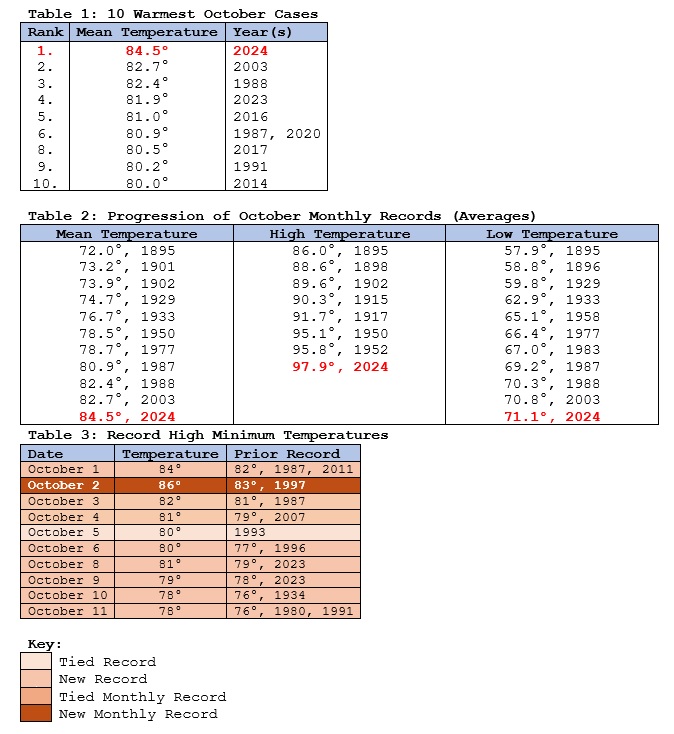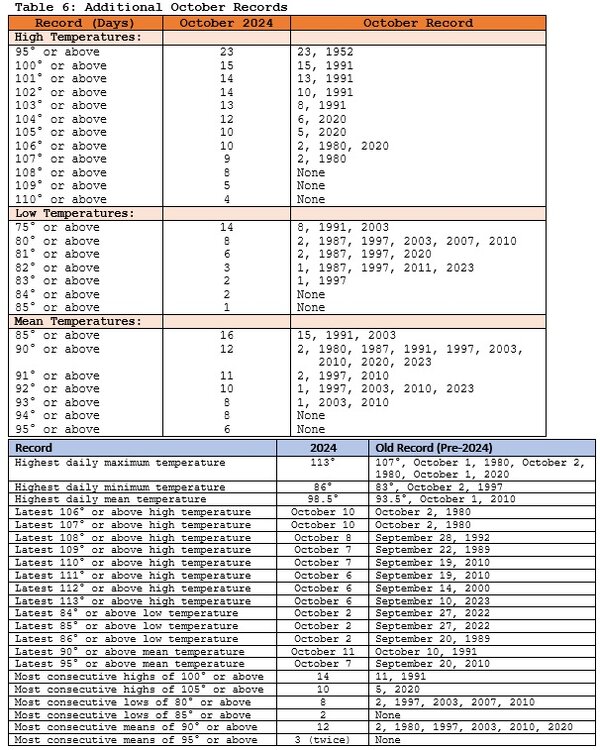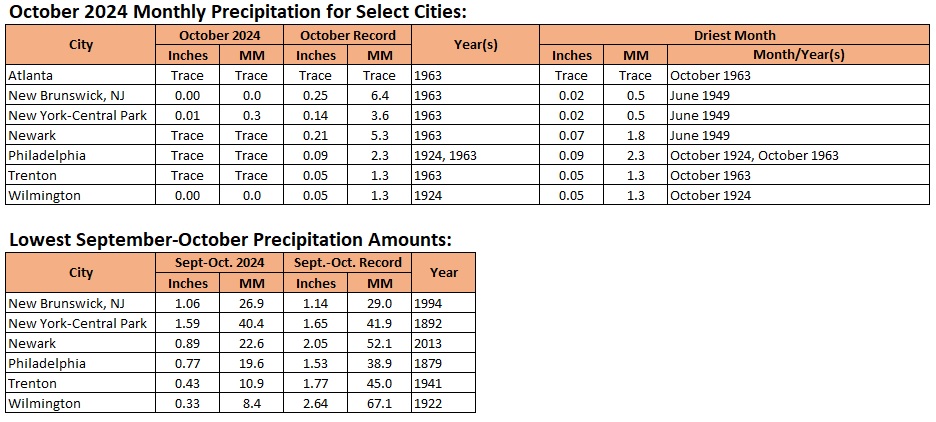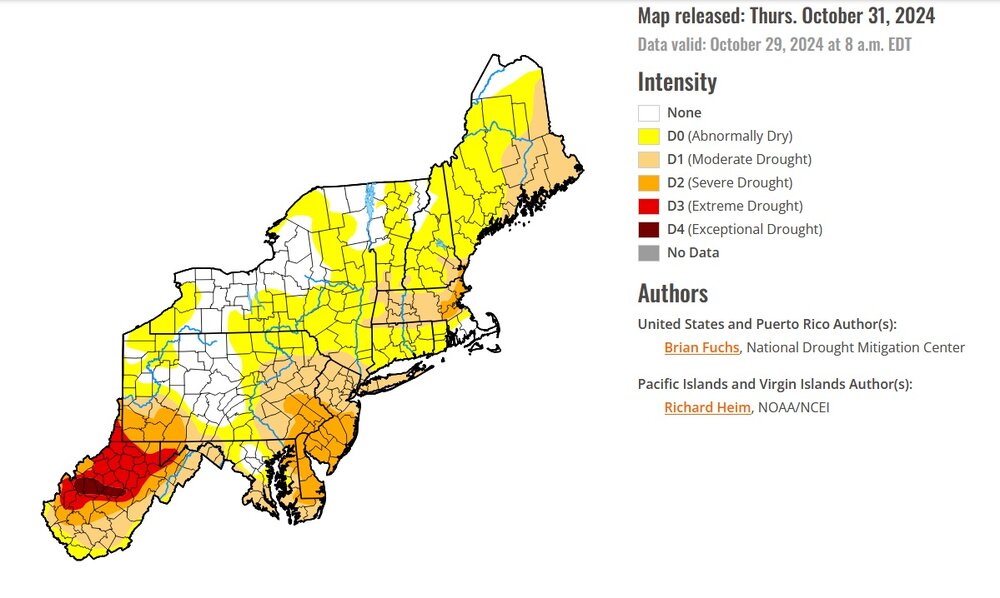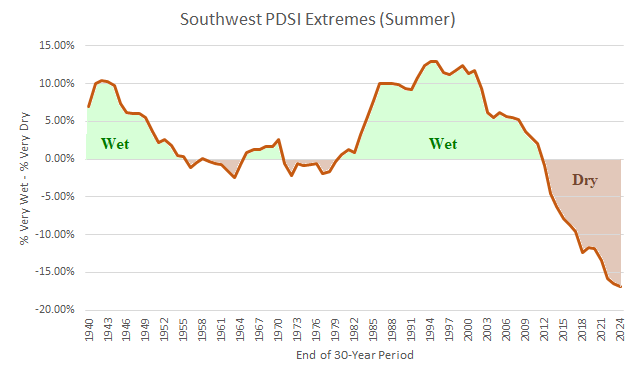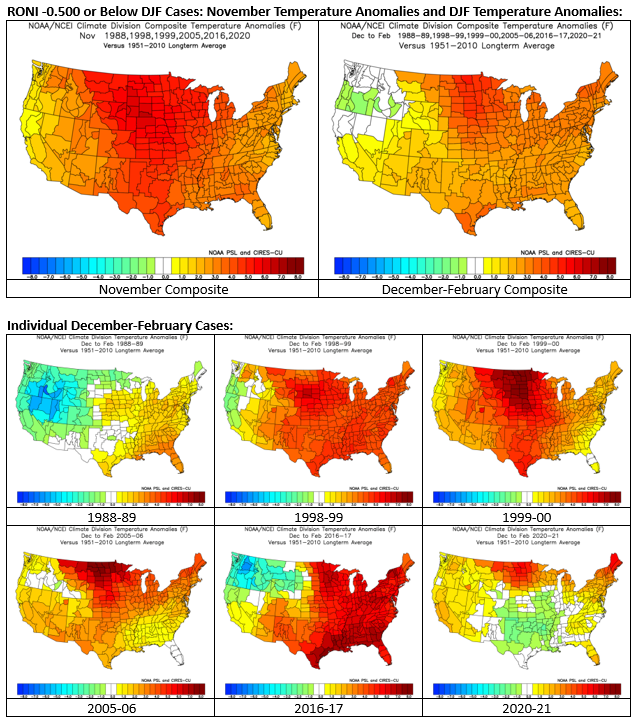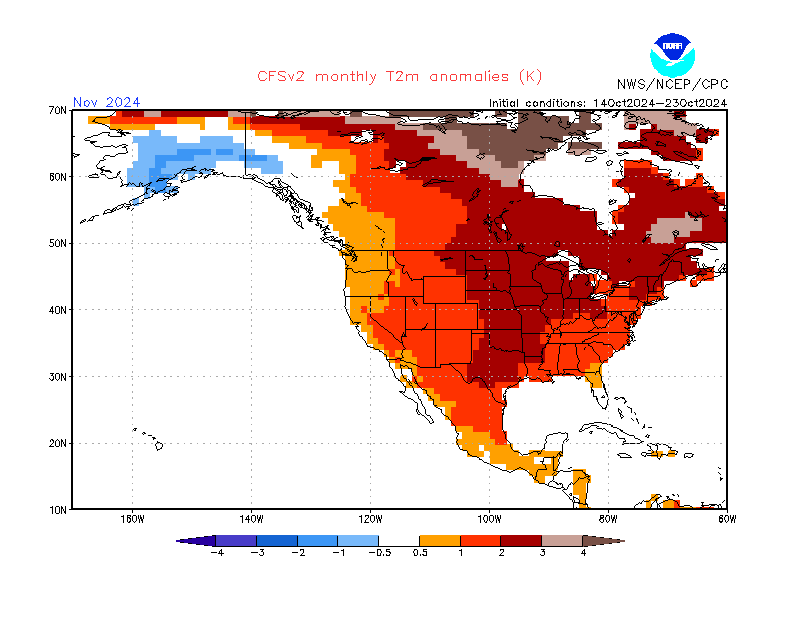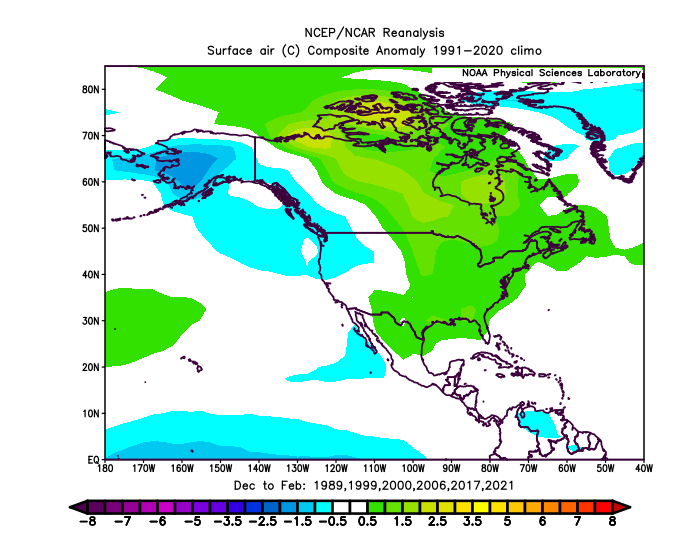-
Posts
22,910 -
Joined
Content Type
Profiles
Blogs
Forums
American Weather
Media Demo
Store
Gallery
Everything posted by donsutherland1
-
A cooler air mass covers the region. Tomorrow will see highs top out in the middle 50s. Lows in New York City will be in the lower 40s with 30s outside the City. Frost is likely outside New York City, as well. Afterward, a warming trend will commence. Tuesday and Wednesday could be very warm days with some locations challenging or breaking records on Wednesday. Today is Philadelphia's 35th consecutive day with no measurable precipitation. The old record of 29 days was set during October 11 through November 8, 1874. Wilmington, DE has also gone 35 consecutive days without measurable precipitation. The old record of 34 days was set during January 7 through February 9, 1909. The NAO fell to a preliminary -2.751 on September 24th (all-time September record: -2.371, September 12, 1971). That was the 9th lowest value on record. La Niña winters following September cases where the NAO fell to -1.900 or below featured a predominantly positive NAO. The most recent such winters were 2016-2017 and 2022-2023. The mean temperatures for those winters in New York City were 39.3° and 41.0° respectively. The 1991-2020 normal value is 36.2°. A warmer outcome is favored by the October run of the C3S multi-model forecast for Winter 2024-2025. The ENSO Region 1+2 anomaly was -0.2°C and the Region 3.4 anomaly was -0.5°C for the week centered around October 23. For the past six weeks, the ENSO Region 1+2 anomaly has averaged -0.30°C and the ENSO Region 3.4 anomaly has averaged -0.38°C. Neutral ENSO conditions will likely evolve into a La Niña event during the late fall. The SOI was -9.93 today. The preliminary Arctic Oscillation (AO) was +0.449 today.
-
November started off with near record and record warmth. Records included: Bangor: 73° (old record: 71°, 1971 and 2003) Boston: 79° (old record: 77°, 1974 Bridgeport: 81° (old record: 71°, 2019) ***new monthly record*** Hartford: 84° (old record: 81°, 1974) ***new monthly record*** Islip: 80° (old record: 77°, 1982) *** tied monthly record*** New York City-JFK Airport: 82° (old record: 80°, 1950) ***new monthly record*** Portland: 74° (tied record set in 1974 and tied in 2003) Providence: 80°(old record: 78°, 1974) Worcester: 77° (old record: 73°, 2003) A cooler air mass is now overspreading the region. During the weekend, highs will generally be in the middle and upper 50s. Lows in New York City will be in the 40s with some 30s outside the City. Today is Philadelphia's 34th consecutive day with no measurable precipitation. The old record of 29 days was set during October 11 through November 8, 1874. The NAO fell to a preliminary -2.751 on September 24th (all-time September record: -2.371, September 12, 1971). That was the 9th lowest value on record. La Niña winters following September cases where the NAO fell to -1.900 or below featured a predominantly positive NAO. The most recent such winters were 2016-2017 and 2022-2023. The mean temperatures for those winters in New York City were 39.3° and 41.0° respectively. The 1991-2020 normal value is 36.2°. A warmer outcome is favored by the October run of the C3S multi-model forecast for Winter 2024-2025. The ENSO Region 1+2 anomaly was -0.2°C and the Region 3.4 anomaly was -0.5°C for the week centered around October 23. For the past six weeks, the ENSO Region 1+2 anomaly has averaged -0.30°C and the ENSO Region 3.4 anomaly has averaged -0.38°C. Neutral ENSO conditions will likely evolve into a La Niña event during the late fall. The SOI was +3.37 today. The preliminary Arctic Oscillation (AO) was +0.449 today.
-
- 1,188 replies
-
- 4
-

-

-

-
Powered by an unprecedented record-melting autumn heatwave that was unlike anything in the Southwest’s climate record, Phoenix experienced its warmest October on record. “Unprecedented” seems almost inadequate to describe the heatwave that stretched from the last week of September through the first week of October. During the first eight days of October, Phoenix eclipsed the previous monthly record high temperature on eight consecutive days. It also set a new monthly record high minimum temperature on two consecutive days. Climate change has played a large role. The 25th and 75th percentiles climate model projections (RCP 4.5) for fall were 72.9°-75.1° during 1961-1990 and 74.5°-76.7° for 1991-2020. The actual outcomes were 73.8° and 77.1°, respectively. The climate model projections for 2001-2030 are 75.1°-77.5°. The projections for 2011-2040 are 75.7°-78.2°.
-
October ended with exceptionally warm readings. Records fell across much of the northern Mid-Atlantic and southern New England areas. New York City finished with a monthly mean temperature of 60.9°, which was 3.0° above normal. High temperatures included: Albany: 79° (old record: 75°, 2019) Allentown: 82° (old record: 81°, 1950) ***highest temperature so late in the season*** Bangor: 78° (old record: 71°, 1956) ***highest temperature so late in the season*** Binghamton: 75° (old record: 70°, 2003) Bridgeport: 77° (old record: 75°, 2004) Burlington: 77° (old record: 71°, 2019) ***highest temperature so late in the season*** Caribou: 77° (old record: 69°, 1942, 1956, 1989) ***highest temperature so late in the season*** Concord: 79° (old record: 78°, 1946) Harrisburg: 82° (old record: 81°, 1950) Hartford: 84° (old record: 82°, 1946) ***highest temperature so late in the season*** Islip: 80° (old record: 73°, 2004) Manchester: 81° (old record: 75°, 1999) New York City-Central Park: 81° (tied record set in 1946) New York City-JFK Airport: 78° (old record: 75°, 1950) New York City-LaGuardia Airport: 83° (old record: 81°, 1946) Newark: 83° (old record: 82°, 1946) Philadelphia: 82° (tied record set in 1946) Poughkeepsie: 82° (old record: 78°, 1946) Scranton: 79°(old record: 75°, 1950) Syracuse: 81° (old record: 75°, 2003) Trenton: 82° (old record: 81°, 1946) Wilmington: 82° (tied record set in 1946) November will get off to a very warm start with temperatures topping out in the lower to middle 70s. Parts of the region could reach or exceed 80°. Through today, New York City had seen just 0.01" of rainfall for October. That makes October 2024 New York City's driest month on record. At Philadelphia, rainfall has been a trace, which also set a new all-time monthly record. Today is Philadelphia's 33rd consecutive day with no measurable precipitation. The old record of 29 days was set during October 11 through November 8, 1874. Select October rainfall amounts and October and Monthly Record Low Precipitation Amounts: Allentown: October 2024: 0.02" Old October Record: 0.15", 1963 Old Monthly Record: 0.09", May 1964 Period of Record: January 1912-Present New Brunswick: October 2024: None Old October Record: 0.25", 1963 Old Monthly Record: 0.02", June 1949 Period of Record: January 1893-Present New York City: October 2024: 0.01" Old October Record: 0.14", 1963 Old Monthly Record: 0.02", June 1949 Period of Record: January 1869-Present Newark: October 2024: Trace Old October Record: 0.21", 1963 Old Monthly Record: 0.07", June 1949 Period of Record: January 1893-Present Philadelphia: October 2024: Trace Old October Record: 0.09", 1924 and 1963 Old Monthly Record: 0.09:, October 1924 and October 1963 Period of Record: November 1871-Pesent Trenton: October 2024: Trace Old October Record: 0.05", 1963 Old Monthly Record: 0.05", October 1963 Period of Record: September 1865-Present Wilmington, DE: October 2024: Trace Old October Record: 0.05", 1924 Old Monthly Record: 0.05", October 1924 Period of Record: January 1894-Present Allentown (1.32"), New Brunswick (1.06"), New York City (1.59"), Newark (0.89"), Philadelphia (0.77"), Trenton (0.43"), and Wilmington (0.33") also saw their lowest rainfall for September 1-October 31. November will very likely to be warmer to perhaps much warmer than normal in the northern Mid-Atlantic region. Already, the sensitivity study is suggesting a 69% probability of a warmer than normal November and a 55% probability of a 50° or above mean temperature in New York City. Those are exceptionally high probabilities at a timeframe where model error is high. The NAO fell to a preliminary -2.751 on September 24th (all-time September record: -2.371, September 12, 1971). That was the 9th lowest value on record. La Niña winters following September cases where the NAO fell to -1.900 or below featured a predominantly positive NAO. The most recent such winters were 2016-2017 and 2022-2023. The mean temperatures for those winters in New York City were 39.3° and 41.0° respectively. The 1991-2020 normal value is 36.2°. A warmer outcome is favored by the October run of the C3S multi-model forecast for Winter 2024-2025. The ENSO Region 1+2 anomaly was -0.2°C and the Region 3.4 anomaly was -0.5°C for the week centered around October 23. For the past six weeks, the ENSO Region 1+2 anomaly has averaged -0.30°C and the ENSO Region 3.4 anomaly has averaged -0.38°C. Neutral ENSO conditions will likely evolve into a La Niña event during the late fall. The SOI was -3.93 yesterday. The preliminary Arctic Oscillation (AO) was +0.686 today.
- 1,188 replies
-
- 3
-

-

-
I believe parts of the region were in extreme drought during 1964-65.
- 1,188 replies
-
Numerous cities, particularly in the northern Mid-Atlantic region, saw all-time monthly record low precipitation. Numerous cities also experienced their driest September 1-October 31 period on record. Drought in the Northeastern U.S. continued to expand.
- 1,188 replies
-
Tomorrow will be an exceptionally warm day. Temperatures could challenge records in parts of the region with the mercury topping out well into the 70s across much of the region. The warmest spots, including Hartford, Newark and Philadelphia, will likely reach or exceed 80°. Through 5 pm EDT today, New York City has seen just 0.01" of rainfall for October. The old record low figure through October 30 was 0.14" in 1963. At Philadelphia, rainfall has been a trace. The prior record was 0.09", which was set in 1924 and tied in 1963. Today is Philadelphia's 31st consecutive day with no measurable precipitation. The old record of 29 days was set during October 11 through November 8, 1874. Precipitation in the northern Mid-Atlantic region will likely remain below to much below normal through October. As a result, October monthly and all-time monthly record low precipitation amounts will likely be approached or broken in parts of the region. Select October and Monthly Record Low Precipitation Amounts: Allentown: October: 0.15", 1963 Monthly: 0.09", May 1964 Period of Record: January 1912-Present New York City: October: 0.14", 1963 Monthly: 0.02", June 1949 Period of Record: January 1869-Present Newark: October: 0.21", 1963 Monthly: 0.07", June 1949 Period of Record: January 1893-Present Philadelphia: October: 0.09", 1924 and 1963 Monthly: 0.09:, October 1924 and October 1963 Period of Record: November 1871-Pesent Trenton: October: 0.05", 1963 Monthly: 0.05", October 1963 Period of Record: September 1865-Present Wilmington, DE: October: 0.05", 1924 Monthly: 0.05", October 1924 Period of Record: January 1894-Present Looking beyond October, November is likely to be warmer to perhaps much warmer than normal in the northern Mid-Atlantic region. Already, the sensitivity study is suggesting a 69% probability of a warmer than normal November and a 54% probability of a 50° or above mean temperature in New York City. Those are exceptionally high probabilities at a timeframe where model error is high. The NAO fell to a preliminary -2.751 on September 24th (all-time September record: -2.371, September 12, 1971). That was the 9th lowest value on record. La Niña winters following September cases where the NAO fell to -1.900 or below featured a predominantly positive NAO. The most recent such winters were 2016-2017 and 2022-2023. The mean temperatures for those winters in New York City were 39.3° and 41.0° respectively. The 1991-2020 normal value is 36.2°. A warmer outcome is favored by the October run of the C3S multi-model forecast for Winter 2024-2025. The ENSO Region 1+2 anomaly was -0.2°C and the Region 3.4 anomaly was -0.5°C for the week centered around October 23. For the past six weeks, the ENSO Region 1+2 anomaly has averaged -0.30°C and the ENSO Region 3.4 anomaly has averaged -0.38°C. Neutral ENSO conditions will likely evolve into a La Niña event during the late fall. The SOI was -3.93 today. The preliminary Arctic Oscillation (AO) was +1.246 today. Based on sensitivity analysis applied to the latest guidance, there is an implied near 100% probability that New York City will have a warmer than normal October (1991-2020 normal). October will likely finish with a mean temperature near 60.7° (2.8° above normal).
- 1,188 replies
-
- 1
-

-
Phoenix remains on course to see its warmest October on record. Looking back at the summer, the U.S. Southwest has been experiencing hotter summers, both in terms of minimum and maximum temperatures. The increased heat has been translating into extreme temperatures (upper 10% of the climate record). The regional figures (percentage of area experiencing extreme temperatures) include all areas, not just urban areas. That a growing share of the region is experiencing extreme readings demonstrates that UHI is not driving the warmth; it is amplifying the warmth in cities such as Phoenix, but the entire region, including rural areas, is warming. Maximum Temperatures: Percentage of Region with Average Maximum Temperatures in the Highest/Lowest 10th percentile: Minimum Temperatures: Percentage of Region with Average Minimum Temperatures in the Highest/Lowest 10th percentile: The data also suggests that a long-term process of aridification may be in its early stages. Regional aridification is predicted by the climate models. More data will be required for a more definitive conclusion on that issue. The data shows that the percentage of the region experiencing severe drought (lowest 10th percentile) based on the Palmer Drought Severity Index (PDSI) has also been increasing in recent years.
-
The warmup will continue tomorrow with the temperature reaching or exceeding 70° in parts of the region. The warmth will crest on Thursday with temperatures topping out well into the 70s across much of the region. The warmest spots, including Hartford, Newark and Philadelphia, will likely reach or exceed 80°. Already, records were tied or broken in the Midwest. Records included: Cleveland: 78° (tied record set in 1946) Detroit: 79° (old record: 77°, 1999) Green Bay: 82° (old record: 77°, 1937) Milwaukee: 81° (tied record set in 1937) Minneapolis: 80° (old record: 78°, 1922) Green Bay's reading was the latest 80° or above temperature on record. The prior latest such temperature occurred on October 23, 1899. Through 5 pm EDT today, New York City has seen just 0.01" of rainfall for October. The old record low figure through October 29 was 0.14" in 1963. At Philadelphia, rainfall has been a trace. The prior record was 0.09", which was set in 1924 and tied in 1963. Today is Philadelphia's 31st consecutive day with no measurable precipitation. The old record of 29 days was set during October 11 through November 8, 1874. Precipitation in the northern Mid-Atlantic region will likely remain below to much below normal through October. As a result, October monthly and all-time monthly record low precipitation amounts will likely be approached or broken in parts of the region. Select October and Monthly Record Low Precipitation Amounts: Allentown: October: 0.15", 1963 Monthly: 0.09", May 1964 Period of Record: January 1912-Present New York City: October: 0.14", 1963 Monthly: 0.02", June 1949 Period of Record: January 1869-Present Newark: October: 0.21", 1963 Monthly: 0.07", June 1949 Period of Record: January 1893-Present Philadelphia: October: 0.09", 1924 and 1963 Monthly: 0.09:, October 1924 and October 1963 Period of Record: November 1871-Pesent Trenton: October: 0.05", 1963 Monthly: 0.05", October 1963 Period of Record: September 1865-Present Wilmington, DE: October: 0.05", 1924 Monthly: 0.05", October 1924 Period of Record: January 1894-Present Looking beyond October, November is likely to be warmer to perhaps much warmer than normal in the northern Mid-Atlantic region. The NAO fell to a preliminary -2.751 on September 24th (all-time September record: -2.371, September 12, 1971). That was the 9th lowest value on record. La Niña winters following September cases where the NAO fell to -1.900 or below featured a predominantly positive NAO. The most recent such winters were 2016-2017 and 2022-2023. The mean temperatures for those winters in New York City were 39.3° and 41.0° respectively. The 1991-2020 normal value is 36.2°. A warmer outcome is favored by the October run of the C3S multi-model forecast for Winter 2024-2025. The ENSO Region 1+2 anomaly was -0.2°C and the Region 3.4 anomaly was -0.5°C for the week centered around October 23. For the past six weeks, the ENSO Region 1+2 anomaly has averaged -0.30°C and the ENSO Region 3.4 anomaly has averaged -0.38°C. Neutral ENSO conditions will likely evolve into a La Niña event during the late fall. The SOI was -3.87 today. The preliminary Arctic Oscillation (AO) was +1.900 today. Based on sensitivity analysis applied to the latest guidance, there is an implied near 100% probability that New York City will have a warmer than normal October (1991-2020 normal). October will likely finish with a mean temperature near 60.6° (2.7° above normal).
- 1,188 replies
-
- 3
-

-
A warmup will develop starting tomorrow. The warmth will likely crest on Thursday with temperatures topping out well into the 70s across much of the region. The warmest spots could reach 80°. Through today, New York City has seen just a trace of rainfall for October. The old record low figure through October 28 was 0.03" in 1973. At Philadelphia, rainfall has also been a trace. The prior record was 0.09", which was set in 1924 and tied in 1963. Today is Philadelphia's 30th consecutive day with no measurable precipitation. That breaks the all-time record streak of 29 days that was set during October 11 through November 8, 1874. Precipitation in the northern Mid-Atlantic region will likely remain below to much below normal through October. As a result, October monthly and all-time monthly record low precipitation amounts will likely be approached or broken in parts of the region. Select October and Monthly Record Low Precipitation Amounts: Allentown: October: 0.15", 1963 Monthly: 0.09", May 1964 Period of Record: January 1912-Present New York City: October: 0.14", 1963 Monthly: 0.02", June 1949 Period of Record: January 1869-Present Newark: October: 0.21", 1963 Monthly: 0.07", June 1949 Period of Record: January 1893-Present Philadelphia: October: 0.09", 1924 and 1963 Monthly: 0.09:, October 1924 and October 1963 Period of Record: November 1871-Pesent Trenton: October: 0.05", 1963 Monthly: 0.05", October 1963 Period of Record: September 1865-Present Wilmington, DE: October: 0.05", 1924 Monthly: 0.05", October 1924 Period of Record: January 1894-Present Looking beyond October, November is likely to be warmer to perhaps much warmer than normal in the northern Mid-Atlantic region. The NAO fell to a preliminary -2.751 on September 24th (all-time September record: -2.371, September 12, 1971). That was the 9th lowest value on record. La Niña winters following September cases where the NAO fell to -1.900 or below featured a predominantly positive NAO. The most recent such winters were 2016-2017 and 2022-2023. The mean temperatures for those winters in New York City were 39.3° and 41.0° respectively. The 1991-2020 normal value is 36.2°. A warmer outcome is favored by the October run of the C3S multi-model forecast for Winter 2024-2025. The ENSO Region 1+2 anomaly was -0.2°C and the Region 3.4 anomaly was -0.5°C for the week centered around October 23. For the past six weeks, the ENSO Region 1+2 anomaly has averaged -0.30°C and the ENSO Region 3.4 anomaly has averaged -0.38°C. Neutral ENSO conditions will likely evolve into a La Niña event during the late fall. The SOI was +2.38 today. The preliminary Arctic Oscillation (AO) was +1.569 today. Based on sensitivity analysis applied to the latest guidance, there is an implied near 100% probability that New York City will have a warmer than normal October (1991-2020 normal). October will likely finish with a mean temperature near 60.6° (2.7° above normal).
- 1,188 replies
-
- 2
-

-
The market is reacting to the already warm guidance that has been growing even warmer for December.
-
Tomorrow will be another fair but chilly day. Temperatures will top out in the middle and upper 50s after starting in the 30s outside New York City and lower 40s in New York City. Afterward, it will warm up quickly early next week. The month could end with widespread temperatures well into the 70s. Through today, New York City has seen just a trace of rainfall for October. The old record low figure through October 27 was 0.02" in 1947. At Philadelphia, rainfall has also been a trace. The prior record was 0.05", which was set in 1947. Today is Philadelphia's 29th consecutive day with no measurable precipitation. That ties the record streak of 29 days set during October 11 through November 8, 1874. That record will very likely be broken tomorrow. Precipitation in the northern Mid-Atlantic region will likely remain below to much below normal through October. As a result, October monthly and all-time monthly record low precipitation amounts will likely be approached or broken in parts of the region. Select October and Monthly Record Low Precipitation Amounts: Allentown: October: 0.15", 1963 Monthly: 0.09", May 1964 Period of Record: January 1912-Present New York City: October: 0.14", 1963 Monthly: 0.02", June 1949 Period of Record: January 1869-Present Newark: October: 0.21", 1963 Monthly: 0.07", June 1949 Period of Record: January 1893-Present Philadelphia: October: 0.09", 1924 and 1963 Monthly: 0.09:, October 1924 and October 1963 Period of Record: November 1871-Pesent Trenton: October: 0.05", 1963 Monthly: 0.05", October 1963 Period of Record: September 1865-Present Wilmington, DE: October: 0.05", 1924 Monthly: 0.05", October 1924 Period of Record: January 1894-Present The NAO fell to a preliminary -2.751 on September 24th (all-time September record: -2.371, September 12, 1971). That was the 9th lowest value on record. La Niña winters following September cases where the NAO fell to -1.900 or below featured a predominantly positive NAO. The most recent such winters were 2016-2017 and 2022-2023. The mean temperatures for those winters in New York City were 39.3° and 41.0° respectively. The 1991-2020 normal value is 36.2°. A warmer outcome is favored by the October run of the C3S multi-model forecast for Winter 2024-2025. The ENSO Region 1+2 anomaly was -0.1°C and the Region 3.4 anomaly was -0.3°C for the week centered around October 16. For the past six weeks, the ENSO Region 1+2 anomaly has averaged -0.30°C and the ENSO Region 3.4 anomaly has averaged -0.33°C. Neutral ENSO conditions will likely evolve into a La Niña event during the late fall. The SOI was +13.54 today. The preliminary Arctic Oscillation (AO) was +1.421 today. Based on sensitivity analysis applied to the latest guidance, there is an implied near 100% probability that New York City will have a warmer than normal October (1991-2020 normal). October will likely finish with a mean temperature near 60.5° (2.6° above normal).
- 1,188 replies
-
- 2
-

-
A short but sharp intrusion of cooler air is likely for tomorrow into Monday. Temperatures will top out in the middle 50s while lows outside New York City will generally fall into the 30s with lower 40s likely in Central Park. Afterward, it will warm up quickly early next week. The month could end with widespread temperatures well into the 70s. Out West, yet another round of near-record and record heat is affecting Phoenix and Tucson. The heat will persist through tomorrow. Through today, New York City has seen just a trace of rainfall for October. The old record low figure through October 26 was 0.02" in 1947. At Philadelphia, rainfall has also been a trace. The prior record was 0.05", which was set in 1947. Today is Philadelphia's 28th consecutive day with no measurable precipitation (tied for the 2nd longest dry stretch). The record streak of 29 days set during October 11-November 8, 1874 will very likely be tied tomorrow and broken on Monday. Precipitation in the northern Mid-Atlantic region will likely remain below to much below normal through October. As a result, October monthly and all-time monthly record low precipitation amounts will likely be approached or broken in parts of the region. Select October and Monthly Record Low Precipitation Amounts: Allentown: October: 0.15", 1963 Monthly: 0.09", May 1964 Period of Record: January 1912-Present New York City: October: 0.14", 1963 Monthly: 0.02", June 1949 Period of Record: January 1869-Present Newark: October: 0.21", 1963 Monthly: 0.07", June 1949 Period of Record: January 1893-Present Philadelphia: October: 0.09", 1924 and 1963 Monthly: 0.09:, October 1924 and October 1963 Period of Record: November 1871-Pesent Trenton: October: 0.05", 1963 Monthly: 0.05", October 1963 Period of Record: September 1865-Present Wilmington, DE: October: 0.05", 1924 Monthly: 0.05", October 1924 Period of Record: January 1894-Present The NAO fell to a preliminary -2.751 on September 24th (all-time September record: -2.371, September 12, 1971). That was the 9th lowest value on record. La Niña winters following September cases where the NAO fell to -1.900 or below featured a predominantly positive NAO. The most recent such winters were 2016-2017 and 2022-2023. The mean temperatures for those winters in New York City were 39.3° and 41.0° respectively. The 1991-2020 normal value is 36.2°. A warmer outcome is favored by the October run of the C3S multi-model forecast for Winter 2024-2025. The ENSO Region 1+2 anomaly was -0.1°C and the Region 3.4 anomaly was -0.3°C for the week centered around October 16. For the past six weeks, the ENSO Region 1+2 anomaly has averaged -0.30°C and the ENSO Region 3.4 anomaly has averaged -0.33°C. Neutral ENSO conditions will likely evolve into a La Niña event during the late fall. The SOI was +13.02 today. The preliminary Arctic Oscillation (AO) was +2.135 today. Based on sensitivity analysis applied to the latest guidance, there is an implied 99% probability that New York City will have a warmer than normal October (1991-2020 normal). October will likely finish with a mean temperature near 60.3° (2.4° above normal).
- 1,188 replies
-
- 2
-

-
Today, Newark will reach its 27th consecutive day without measurable precipitation today. That will break the all-time record set during March 8-April 2, 1915 and tied during May 30-June 24, 1949.
-
Tomorrow will see temperatures rise to the lower and middle 60s. However, a short but sharp intrusion of cooler air is likely for Sunday into Monday. Afterward, it will warm up quickly early next week. The month could end with widespread temperatures well into the 70s. Out West, yet another round of near-record and record heat is affecting Phoenix and Tucson. The heat will persist through Sunday. Tucson could see its latest 100° temperature on record. Through today, New York City has seen just a trace of rainfall for October. The old record low figure through October 25 was 0.02" in 1947. At Philadelphia, rainfall has also been a trace. That ties the old record of a trace from 1886. Today is Philadelphia's 27th consecutive day with no measurable precipitation (3rd longest dry stretch). The record streak of 29 days set during October 11-November 8, 1874 will likely be broken. Precipitation in the northern Mid-Atlantic region will likely remain below to much below normal through October. As a result, October monthly and all-time monthly record low precipitation amounts will likely be approached or broken in parts of the region. Select October and Monthly Record Low Precipitation Amounts: Allentown: October: 0.15", 1963 Monthly: 0.09", May 1964 Period of Record: January 1912-Present New York City: October: 0.14", 1963 Monthly: 0.02", June 1949 Period of Record: January 1869-Present Newark: October: 0.21", 1963 Monthly: 0.07", June 1949 Period of Record: January 1893-Present Philadelphia: October: 0.09", 1924 and 1963 Monthly: 0.09:, October 1924 and October 1963 Period of Record: November 1871-Pesent Trenton: October: 0.05", 1963 Monthly: 0.05", October 1963 Period of Record: September 1865-Present Wilmington, DE: October: 0.05", 1924 Monthly: 0.05", October 1924 Period of Record: January 1894-Present The NAO fell to a preliminary -2.751 on September 24th (all-time September record: -2.371, September 12, 1971). That was the 9th lowest value on record. La Niña winters following September cases where the NAO fell to -1.900 or below featured a predominantly positive NAO. The most recent such winters were 2016-2017 and 2022-2023. The mean temperatures for those winters in New York City were 39.3° and 41.0° respectively. The 1991-2020 normal value is 36.2°. A warmer outcome is favored by the October run of the C3S multi-model forecast for Winter 2024-2025. The ENSO Region 1+2 anomaly was -0.1°C and the Region 3.4 anomaly was -0.3°C for the week centered around October 16. For the past six weeks, the ENSO Region 1+2 anomaly has averaged -0.30°C and the ENSO Region 3.4 anomaly has averaged -0.33°C. Neutral ENSO conditions will likely evolve into a La Niña event during the late fall. The SOI was +19.14 today. The preliminary Arctic Oscillation (AO) was +3.006 today. Based on sensitivity analysis applied to the latest guidance, there is an implied 98% probability that New York City will have a warmer than normal October (1991-2020 normal). October will likely finish with a mean temperature near 60.3° (2.4° above normal).
- 1,188 replies
-
- 2
-

-
On a month-to-month basis, it remains to be seen how things will ultimately fare. The CFSv2 now shows January as having the potential to have more widespread cold than February. Much can still change between now and the final forecasts. Overall, confidence that the winter as a whole will be mild (though I don't see it being as warm as the past two in the East) has increased. There will be some opportunities for cold and snow--more than the past two winters unless there are some big hostile changes.
-
The cooling trend that got underway today will continue tomorrow. Temperatures will top out in the lower 60s. After a somewhat warmer Saturday, a shortlived but fairly sharp cool shot is likely Sunday into Monday before it warms up quickly early next week. Out West, yet another round of near-record and record heat is affecting Phoenix and Tucson. The heat will persist through Sunday. Tucson could see its latest 100° temperature on record. Through today, New York City has seen just a trace of rainfall for October. The old record low figure through October 24 was 0.02" in 1947. At Philadelphia, rainfall has also been a trace. That ties the old record of a trace from 1886. Further, today is Philadelphia's 26th consecutive day with no measurable precipitation (tied for the 3rd longest dry stretch). The record streak of 29 days set during October 11-November 8, 1874 will likely be challenged or broken. Precipitation in the northern Mid-Atlantic region will likely remain below to much below normal through October. The ECMWF ensembles, along with the experimental AIFS and FuXi AI versions continue to show very little precipitation. As a result, October monthly and all-time monthly record low precipitation amounts will likely be approached or broken in parts of the region. Select October and Monthly Record Low Precipitation Amounts: Allentown: October: 0.15", 1963 Monthly: 0.09", May 1964 Period of Record: January 1912-Present New York City: October: 0.14", 1963 Monthly: 0.02", June 1949 Period of Record: January 1869-Present Newark: October: 0.21", 1963 Monthly: 0.07", June 1949 Period of Record: January 1893-Present Philadelphia: October: 0.09", 1924 and 1963 Monthly: 0.09:, October 1924 and October 1963 Period of Record: November 1871-Pesent Trenton: October: 0.05", 1963 Monthly: 0.05", October 1963 Period of Record: September 1865-Present Wilmington, DE: October: 0.05", 1924 Monthly: 0.05", October 1924 Period of Record: January 1894-Present The NAO fell to a preliminary -2.751 on September 24th (all-time September record: -2.371, September 12, 1971). That was the 9th lowest value on record. La Niña winters following September cases where the NAO fell to -1.900 or below featured a predominantly positive NAO. The most recent such winters were 2016-2017 and 2022-2023. The mean temperatures for those winters in New York City were 39.3° and 41.0° respectively. The 1991-2020 normal value is 36.2°. A warmer outcome is favored by the October run of the C3S multi-model forecast for Winter 2024-2025. The ENSO Region 1+2 anomaly was -0.1°C and the Region 3.4 anomaly was -0.3°C for the week centered around October 16. For the past six weeks, the ENSO Region 1+2 anomaly has averaged -0.30°C and the ENSO Region 3.4 anomaly has averaged -0.33°C. Neutral ENSO conditions will likely evolve into a La Niña event during the late fall. The SOI was +16.31 today. The preliminary Arctic Oscillation (AO) was +3.658 today. Based on sensitivity analysis applied to the latest guidance, there is an implied 97% probability that New York City will have a warmer than normal October (1991-2020 normal). October will likely finish with a mean temperature near 60.0° (2.1° above normal).
- 1,188 replies
-
- 1
-

-
The latest CFSv2 forecast for November indicates that most of the CONUS will be warmer than normal. Thus, the question becomes what kind of winter would be likely to follow such a November. With the December 2024-February 2025 Relative ENSO Region 3.4 Index (RONI) likely to average -0.500 or below, it makes some sense to examine how CONUS winters have fared in the past with winter values of -0.500 or below following widespread November warmth in the CONUS (1951-2010 baseline) since 1949-50. The Composite Temperature Anomalies for North America (1991-2020 baseline, as the larger period was not available) were as follows: November: December-February: The most recent C3S Multi-Ensemble Forecast for December 2024-2025: It should be noted that even warm winters have often seen periods of cold. In cases, there have been some periods of severe cold. Overall, the forecast winter anomalies are reasonably in line with those that have followed the kind of November that is forecast when the winter RONI averaged -0.500 or below.
-
It will turn cooler tomorrow with the mercury being confined to the 60s. A shortlived but fairly sharp cool shot is likely Sunday into Monday before it warms up quickly early next week. Out West, yet another round of near-record and record heat is affecting Phoenix and Tucson. The heat will persist through Sunday. Tucson could see its latest 100° temperature on record. Through today, New York City has seen just a trace of rainfall for October. The old record low figure through October 23 was 0.02" in 1947. At Philadelphia, rainfall has been 0.00". The old record was a trace during 1886. Further, today is Philadelphia's 25th consecutive day with no measurable precipitation (tied for the 4th longest dry stretch). The record streak of 29 days set during October 11-November 8, 1874 will likely be challenged or broken. Precipitation in the northern Mid-Atlantic region will likely remain below to much below normal through October. The ECMWF ensembles, along with the experimental AIFS and FuXi AI versions continue to show very little precipitation. As a result, October monthly and all-time monthly record low precipitation amounts will likely be approached or broken in parts of the region. Select October and Monthly Record Low Precipitation Amounts: Allentown: October: 0.15", 1963 Monthly: 0.09", May 1964 Period of Record: January 1912-Present New York City: October: 0.14", 1963 Monthly: 0.02", June 1949 Period of Record: January 1869-Present Newark: October: 0.21", 1963 Monthly: 0.07", June 1949 Period of Record: January 1893-Present Philadelphia: October: 0.09", 1924 and 1963 Monthly: 0.09:, October 1924 and October 1963 Period of Record: November 1871-Pesent Trenton: October: 0.05", 1963 Monthly: 0.05", October 1963 Period of Record: September 1865-Present Wilmington, DE: October: 0.05", 1924 Monthly: 0.05", October 1924 Period of Record: January 1894-Present The NAO fell to a preliminary -2.751 on September 24th (all-time September record: -2.371, September 12, 1971). That was the 9th lowest value on record. La Niña winters following September cases where the NAO fell to -1.900 or below featured a predominantly positive NAO. The most recent such winters were 2016-2017 and 2022-2023. The mean temperatures for those winters in New York City were 39.3° and 41.0° respectively. The 1991-2020 normal value is 36.2°. A warmer outcome is favored by the October run of the C3S multi-model forecast for Winter 2024-2025. The ENSO Region 1+2 anomaly was -0.1°C and the Region 3.4 anomaly was -0.3°C for the week centered around October 16. For the past six weeks, the ENSO Region 1+2 anomaly has averaged -0.30°C and the ENSO Region 3.4 anomaly has averaged -0.33°C. Neutral ENSO conditions will likely evolve into a La Niña event during the late fall. The SOI was +11.86 today. The preliminary Arctic Oscillation (AO) was +4.795 today. The preliminary figure exceeds the October monthly record of +4.521 that was set just yesterday. It is also the highest autumn value on record. The old autumn record of +4.544 was set on November 2, 1978. Based on sensitivity analysis applied to the latest guidance, there is an implied 94% probability that New York City will have a warmer than normal October (1991-2020 normal). October will likely finish with a mean temperature near 60.0° (2.1° above normal).
- 1,188 replies
-
- 1
-

-
Today was another brilliant sun-filled day with temperatures reaching the upper 70s and lower 80s across the region. Daily records were set or tied at locations including: Bridgeport: 77° (tied record set in 1975) Islip: 82° (old record: 77°, 1979) New York City-JFK Airport: 80° (old record: 77°, 1975 and 1984) Philadelphia: 84° (old record: 83°, 1920) Trenton: 83° (tied record set in 1979) Wilmington, DE: 82° (old record: 81°, 1979) Tomorrow will be another sunny and unseasonably warm day, but it will be somewhat cooler than today. Temperatures will top out in the lower and middle 70s. It will turn cooler on Thursday with the mercury being confined to the 60s. A shortlived but fairly sharp cool shot is likely Sunday into Monday before it warms up quickly early next week. Out West, yet another round of near-record and record heat will affect Phoenix and Tucson tomorrow through Sunday. Tucson could see its latest 100° temperature on record. Through today, New York City has seen just a trace of rainfall for October. The old record low figure through October 22 was 0.02" in 1947. At Philadelphia, rainfall has been 0.00". The old record was a trace during 1886. Further, today is Philadelphia's 24th consecutive day with no measurable precipitation (tied for the 7th longest dry stretch). The record streak of 29 days set during October 11-November 8, 1874 will likely be challenged or broken. Precipitation in the northern Mid-Atlantic region will likely remain below to much below normal through October. The ECMWF ensembles, along with the experimental AIFS and FuXi AI versions continue to show very little precipitation. As a result, October monthly and all-time monthly record low precipitation amounts will likely be approached or broken in parts of the region. Select October and Monthly Record Low Precipitation Amounts: Allentown: October: 0.15", 1963 Monthly: 0.09", May 1964 Period of Record: January 1912-Present New York City: October: 0.14", 1963 Monthly: 0.02", June 1949 Period of Record: January 1869-Present Newark: October: 0.21", 1963 Monthly: 0.07", June 1949 Period of Record: January 1893-Present Philadelphia: October: 0.09", 1924 and 1963 Monthly: 0.09:, October 1924 and October 1963 Period of Record: November 1871-Pesent Trenton: October: 0.05", 1963 Monthly: 0.05", October 1963 Period of Record: September 1865-Present Wilmington, DE: October: 0.05", 1924 Monthly: 0.05", October 1924 Period of Record: January 1894-Present The NAO fell to a preliminary -2.751 on September 24th (all-time September record: -2.371, September 12, 1971). That was the 9th lowest value on record. La Niña winters following September cases where the NAO fell to -1.900 or below featured a predominantly positive NAO. The most recent such winters were 2016-2017 and 2022-2023. The mean temperatures for those winters in New York City were 39.3° and 41.0° respectively. The 1991-2020 normal value is 36.2°. A warmer outcome is favored by the October run of the C3S multi-model forecast for Winter 2024-2025. The ENSO Region 1+2 anomaly was -0.1°C and the Region 3.4 anomaly was -0.3°C for the week centered around October 16. For the past six weeks, the ENSO Region 1+2 anomaly has averaged -0.30°C and the ENSO Region 3.4 anomaly has averaged -0.33°C. Neutral ENSO conditions will likely evolve into a La Niña event during the late fall. The SOI was +16.44 today. The preliminary Arctic Oscillation (AO) was +4.521 today. The preliminary figure exceeds the prior October monthly record of +3.754, which was set on October 24, 2008. It is also the second highest autumn value, exceeded only by the +4.544 figure on November 2, 1978. Based on sensitivity analysis applied to the latest guidance, there is an implied 91% probability that New York City will have a warmer than normal October (1991-2020 normal). October will likely finish with a mean temperature near 59.8° (1.9° above normal).
- 1,188 replies
-
- 1
-

-
Phoenix and Tucson are poised to see yet another round of record-challenging and record-breaking heat starting tomorrow. Phoenix could see one of its latest 100° temperatures on record. Tucson could see its latest 100° temperature on record.




